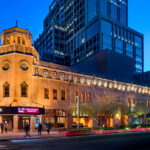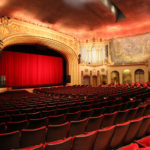Writer Joseph J. Airdo
Photography Courtesy of Orpheum Theatre
[dropcap]A[/dropcap]s one of Phoenix’s oldest and most cherished landmarks still operating today, the historic Orpheum Theatre tells a story that is even grander and more majestic than those found in the many movies and live shows that have played within its walls over the past 90 years.
The Orpheum Theatre, 203 W. Adams St. in Phoenix, first opened its doors on Jan. 5, 1929. Since then, it has undergone a number of programming changes and a dramatic restoration to recover and preserve its original beauty and significance to our state. Venue manager David Cruse calls the Orpheum Theatre “the jewel of downtown Phoenix.”
“It is a really special place,” Cruse explained. “We have people who have come in who had their first kiss there during a movie in the 50s. We have had people come in who met their now-fiancé there. It’s great to hear these stories about people who went there as kids, come back and are just thankful that it still exists.”
The Orpheum’s story began in 1927, when architects Lescher and Mahoney designed and built the theater for owner-operators J.E. Rickards and Harry Nace. The $750,000 construction project featured 1,800 seats, an early form of air conditioning and a stage measuring 101 feet wide and 28 feet deep to accommodate vaudeville productions.
Aesthetically, the Orpheum Theatre was built in the Spanish Baroque style, featuring intricate murals and moldings to give the audience the impression that they were sitting in a garden surrounded by mountains as they enjoyed the show.
“The idea behind it is that it is an atmospheric theater,” said Cruse, noting most of the Orpheum’s earliest programming consisted of “talkies”—the then-new innovation of sound films that included synchronized dialogue—in an effort to be on the cutting edge of entertainment.
“The interior of the auditorium is meant to feel like you’re watching theater in a Spanish villa underneath the stars.”
In addition to serving as Phoenix’s stop on the Orpheum vaudeville circuit, the theater played host to a number of high-profile film premieres, including 1933’s “I’m No Angel,” for which starlet Mae West visited the Valley.
This tradition continued through the theater’s second iteration as the Paramount, when Paramount Pictures purchased the building in 1940.
“There were other historic theaters at that time, some of them right around the corner, but the Orpheum still remained the movie palace and showpiece of Phoenix through that era,” Cruse explained.
A far more dramatic change occurred in 1968, when James Nederlander of Nederlander Theatrical Corporation purchased the building, changed its name to Palace West and designated it a stop on the Broadway circuit. Many current Valley residents best remember the building for its live programming during this time.
In the 1970s, when the Broadway musical scene began bigger and more expensive productions, costs became prohibitive. As a result, Nederlander leased the building to the Corona family, who operated the theater as a Spanish movie house into the 1980s.
Although this iteration greatly served the Valley’s Spanish-speaking community, it also saw the theater’s beautiful interior muted in order to mimic the dark aesthetics of the multiplexes that had been popping up around the country.
“Everything was painted black,” said Cruse. The theater’s original murals and paintings disappeared, covered up by black paint and movie posters. “That was keeping in line with what movie theaters at that time looked like.”
It eventually appeared as though the aging and deteriorating building was destined to be razed in favor of a parking lot. Instead, the City of Phoenix stepped in, purchasing the property in 1984. It was added to the National Register of Historic Places the next year.
“Phoenix still gets a little bit of a bum rap for losing a lot of the past history, so this became sort of an opportunity to return something to its former glory and preserve history alongside something brand new—and that brand new project was City Hall.”
In 1988, voters approved $7 million in funds to restore the theater. An additional $7 million in was raised by the then-newly founded Orpheum Theatre Foundation, and the city’s plan to incorporate the building into its new City Hall was put into motion by Conrad Schmitt Studios.
“The new Phoenix City Hall is attached to the Orpheum Theatre,” said Cruse, noting that the two buildings share a common wall. “The idea of old-meets-new and the two sort of sharing the same space was very attractive to the city. They certainly went all-in on it.”
A tremendous amount of care was utilized in order to painstakingly restore all of the theater’s plasterwork and peel away the black paint to recover the original murals and paintings underneath.
Meanwhile, the Adams Street side ground floor of the theater, a one-time home to small shops like ice cream parlors and florists, was incorporated into an expanded lobby and box office with windows designed to resemble storefronts from its original time period.
The Orpheum Theatre reclaimed its name in 1991 and finally reopened in all of its 1929 glory on Jan. 28, 1997, with a live performance of “Hello, Dolly!” starring Carol Channing.
Today, the theater specializes in an eclectic mix of programming, including live theater, concerts, stand-up comedy, children’s shows and dance performances. It even plays host to world-class speakers and authors while also supporting the community as a space for the occasional graduation and dance recital.
“There are a lot of exciting things happening in downtown Phoenix these days. The Orpheum is looking to sort of be the center of that. It was the beginning of that so we would certainly like to see it be the future of that as well,” Cruse said.
“We want the Orpheum Theatre to lead the way in the Valley as to what live entertainment should feel like and be like,” he added. “We want to continue that [innovation] inside the walls of this historic building; preserve history surrounded by and inclusive of all that forward and future thinking.”
No matter how far Phoenix ventures into cutting-edge technology, the Orpheum Theatre will retain its historic charm and embrace its humble beginnings. One such way it is doing so is through Silent Sundays, programming in which a classic silent film is accompanied by the Mighty Wurlitzer Organ which, like the theater itself, has been fully restored. The next such event is scheduled for Oct. 28 and will feature 1925’s “The Phantom of the Opera.”
Meanwhile, volunteer organization Friends of the Orpheum Theatre partners with the City of Phoenix to keep the history of the legendary landmark alive through free public tours held at noon and 1 p.m. on the first and third Tuesdays of each month. Although access is at times limited due to the needs of certain performances, visitors generally receive an in-depth, behind-the-scenes look at the theater through a historical lens.
Visitors this time of the year can also see a spooky side of the Orpheum Theatre with a series of ghost tours throughout the month of October, including on Halloween. The theater has, indeed, had its fair share of ghostly sightings. Tickets for those events, which require paid admission and typically sell out quickly, are available online.
Orpheum Theatre Tours
First and Third Tuesdays of Each Month
Noon and 1 p.m.
The Orpheum Theatre
203 W. Adams St., Phoenix
Free to Attend
602-495-7139










Comments by Admin